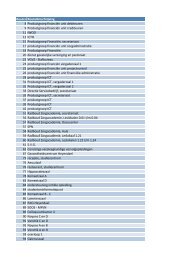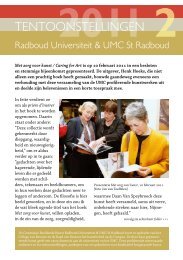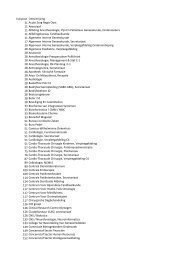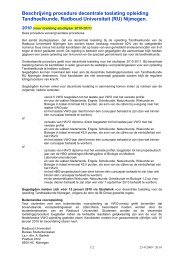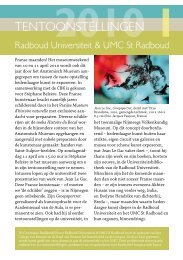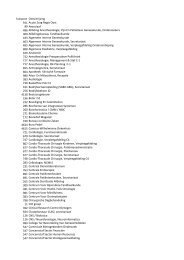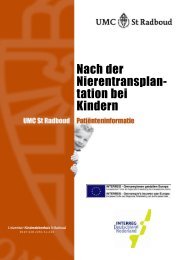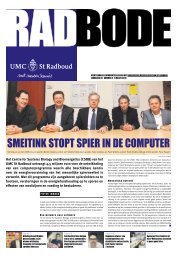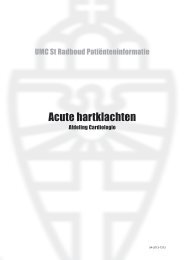Neuralgic Amyotrophy: idiopathic and hereditary ... - UMC St Radboud
Neuralgic Amyotrophy: idiopathic and hereditary ... - UMC St Radboud
Neuralgic Amyotrophy: idiopathic and hereditary ... - UMC St Radboud
Create successful ePaper yourself
Turn your PDF publications into a flip-book with our unique Google optimized e-Paper software.
ecover for the most part, but that, after a second or third time, will not recover as<br />
completely <strong>and</strong>, ultimately, will not be able to recover at all. The loss of strength,<br />
but also the disorders in sensation <strong>and</strong> blood supply to the skin, then become<br />
permanent.<br />
There is no known medication that can stimulate the recovery of nerves. As a<br />
warning against all types of ads on the internet: vitamin B6, in high doses, can<br />
even damage the nerves. In addition, electrical stimulation of the muscle in order<br />
to strengthen the muscle mass is advised against because this will likely hinder<br />
the regeneration of the nerve by the body. However, with NA there are no objections<br />
to the milder electrical currents that are used in the so-called TENS treatment<br />
(see chapter 9).<br />
There are other factors that also play a role in how fast <strong>and</strong> how fully patients can<br />
recover. For most of the muscles, one can say that they function well in daily life<br />
once they have regained 70% of their former strength. However, some muscles<br />
must truly be nearly 100% recovered before they can function normally again.<br />
The muscle that, when it fails, causes a protruding shoulder blade, (the serratus<br />
anterior) is the most important example of this. Because this muscle needs its<br />
maximum strength <strong>and</strong> endurance in order to work well, it sometimes seems as<br />
if recovery of the nerve to this muscle takes much longer than the recovery of the<br />
other nerves. That is probably not the case. It simply takes longer before it makes<br />
a difference to you.<br />
Complications<br />
In spite of the fact that there is recovery of strength, more than half of NA patients<br />
develop persisting pain symptoms. This pain is generally the result of overtaxing<br />
both the weakened muscles <strong>and</strong> the muscles that must compensate for them.<br />
Through the pain <strong>and</strong> the decreased strength, NA patients are often hampered in<br />
carrying out such daily activities as household tasks or work. The most important<br />
constraints are often in the difficulty with reaching <strong>and</strong> lifting. However, also<br />
non-strenuous repetitive movement (such as typing or ironing) or sitting in one<br />
position for a long time can induce <strong>and</strong> maintain this type of pain symptoms. If NA<br />
patients, nonetheless, continue to carry out their normal activities, this often hap-<br />
14<br />
pens unconsciously by much compensating <strong>and</strong> overtaxing. This means that the<br />
movements are no longer done in a normal way but by using other muscles or by<br />
tightening the entire body. This way of moving often costs much more energy than<br />
the normal way <strong>and</strong> leads more quickly to overtaxing <strong>and</strong> chronic muscular pain.<br />
Sometimes, the shoulder moves in a totally different way than normal so that,<br />
consequently, new pain symptoms develop.<br />
In the normal situation, most people do not even think about how their shoulder<br />
moves. Someone generally only thinks about what he or she wants to do or pick<br />
up with the h<strong>and</strong>. What the body must regulate beforeh<strong>and</strong> with respect to the<br />
shoulder in order to be able to use the h<strong>and</strong> securely <strong>and</strong> steadily is completely<br />
unconscious. Because of this, NA patients often have no idea which muscles are<br />
weakened – or they are not even aware of muscle weakness – but only know<br />
that the arm is very difficult to move <strong>and</strong> that movement cannot be maintained<br />
for long. Patients are also often not aware that there is a compensating pattern<br />
of movement <strong>and</strong> what the long-term consequences of this can be. They notice<br />
the consequences over time because of the (extra) pain, loss of strength <strong>and</strong>/or<br />
fatigue it causes. Lack of information about the consequences <strong>and</strong> the course of<br />
NA can lead to the feeling that the symptoms are ‘unmanageable’.<br />
The shutting down or partial paralysis of a number of muscles in the shoulder, arm<br />
<strong>and</strong>/or h<strong>and</strong> does not only have consequences for strength. Also, the position of<br />
the shoulder, arm, wrist or fingers can change considerably. If the muscles that<br />
keep the shoulder blade in place shut down, what often occurs is that, through<br />
the weight of the arm, the shoulder shifts a bit downwards <strong>and</strong> to the side. This<br />
then creates problems if the arm is lifted because the space in the shoulder joint,<br />
between the ball of the upper arm <strong>and</strong> the shoulder, is smaller. Thus, the tendons<br />
surrounding the shoulder joint can become pinched during certain movements<br />
(secondary impingement) <strong>and</strong> that is painful. If the shoulder blade droops, the<br />
muscles that are connected to it – starting in the neck <strong>and</strong> the back – become<br />
overstretched. This is also often painful, certainly in the long term. This is especially<br />
because muscles cannot take it if they are stretched out <strong>and</strong> must still<br />
contract.<br />
15



